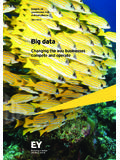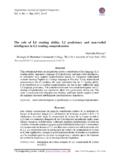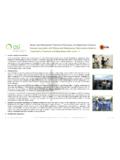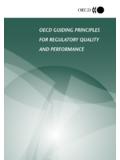Transcription of Tertiary Education for the Knowledge Society - …
1 Tertiary Education for the Knowledge Society OECD Thematic Review of Tertiary Education : Synthesis Report Overview April 2008 OVERVIEW 1 Tertiary Education FOR THE Knowledge Society OECD THEMATIC REVIEW OF Tertiary Education OECD 2008 The report Tertiary Education for the Knowledge Society provides a thorough international investigation of Tertiary Education policy across its many facets governance, funding, quality assurance, equity, research and innovation, academic career, links to the labour market and internationalisation. Its specific concern is policies that ensure that capabilities of Tertiary Education contribute to countries economic and social objectives. The report draws on the results of a major OECD review of Tertiary Education policy the OECD Thematic Review of Tertiary Education - conducted over the 2004-08 period in collaboration with 24 countries around the world (see Box 1).
2 The fact that so many countries took part indicates that Tertiary Education issues are a priority for public policy, and likely to become even more so in future years. The report is intended to: Provide an international comparative analysis of Tertiary Education policy issues; Draw attention to effective policy initiatives in participating countries; Suggest a comprehensive framework to guide Tertiary Education policy development; Identify priorities for follow-up work at national, regional and international levels; and Propose policy directions. Box 1: Methodology and Country Participation The Review was based on participating countries working collaboratively with each other and with the OECD Secretariat. It involved examining country-specific issues and policy responses in Tertiary Education policy, and placing these experiences within a broader framework to generate insights and findings relevant to OECD countries as a whole.
3 The collaborative approach provided countries with an opportunity to learn more about themselves by examining their experiences against those of other countries. It also added to the broader Knowledge base by accumulating international evidence on the impact of policy reforms, and the circumstances under which they work best. The Review involved two complementary approaches: an Analytical Review strand; and a Country Review strand. The Analytical Review strand used several means country background reports, literature reviews, data analyses and commissioned papers to analyse the factors that shape Tertiary Education and possible policy responses. All 24 participating countries were involved in this strand. In addition, fourteen countries chose to host a Country Review, which involved external review teams undertaking an intensive case study visit whose conclusions were then reflected in a Country Note.
4 The countries taking part in the project were: Analytical Review strand (24 countries): Australia, Belgium (Flemish Community), Chile, China, Croatia, the Czech Republic, Estonia, Finland, France, Greece, Iceland, Japan, Korea, Mexico, the Netherlands, New Zealand, Norway, Poland, Portugal, the Russian Federation, Spain, Sweden, Switzerland and the United Kingdom. Country Review strand (14 countries): China, Croatia, the Czech Republic, Estonia, Finland, Iceland, Japan, Korea, Mexico, the Netherlands, New Zealand, Norway, Poland and Spain. All documents produced through the Review are placed on the Review s website: 2 OVERVIEW Tertiary Education FOR THE Knowledge Society OECD THEMATIC REVIEW OF Tertiary Education OECD 2008 The growing focus on Tertiary Education Tertiary Education policy is increasingly important on national agendas. The widespread recognition that Tertiary Education is a major driver of economic competitiveness in an increasingly Knowledge -driven global economy has made high-quality Tertiary Education more important than ever before.
5 The imperative for countries is to raise higher-level employment skills, to sustain a globally competitive research base and to improve Knowledge dissemination to the benefit of Society . Tertiary Education contributes to social and economic development through four major missions: The formation of human capital (primarily through teaching); The building of Knowledge bases (primarily through research and Knowledge development); The dissemination and use of Knowledge (primarily through interactions with Knowledge users); and The maintenance of Knowledge (inter-generational storage and transmission of Knowledge ). The scope and importance of Tertiary Education have changed significantly. Over 40 years ago Tertiary Education , which was more commonly referred to as higher Education , was what happened in universities. This largely covered teaching and learning requiring high level conceptual and intellectual skills in the humanities, sciences and social sciences, the preparation of students for entry to a limited number of professions such as medicine, engineering and law, and disinterested advanced research and scholarship.
6 These days, Tertiary Education is much more diversified and encompasses new types of institutions such as polytechnics, university colleges, or technological institutes. These have been created for a number of reasons: to develop a closer relationship between Tertiary Education and the external world, including greater responsiveness to labour market needs; to enhance social and geographical access to Tertiary Education ; to provide high-level occupational preparation in a more applied and less theoretical way; and to accommodate the growing diversity of qualifications and expectations of school graduates. As participation in Tertiary Education has expanded, Tertiary Education institutions (TEIs) have assumed responsibility for a far wider range of occupational preparation than in the past. As the result of a combination of the increased Knowledge base of many occupations and individual s aspirations, not only doctors, engineers and lawyers but also nurses, accountants, computer programmers, teachers, pharmacists, speech therapists, and business managers now receive their principal occupational qualifications from a TEI.
7 Furthermore, TEIs are now involved in a wider range of teaching than their traditional degree-level courses. While the extent of such teaching is not large, many examples can be found of TEIs that offer adult Education and leisure courses, upper secondary courses to prepare students for Tertiary -level study, and short specific occupational preparation at sub-degree level. In addition, it has become more common for TEIs not only to engage in teaching and research, but also to provide consultancy services to industry and government and to contribute to national and regional economic and social development. Substantial reforms are taking place in Tertiary Education systems mainly aimed at encouraging institutions to be more responsive to the needs of Society and the economy. OVERVIEW 3 Tertiary Education FOR THE Knowledge Society OECD THEMATIC REVIEW OF Tertiary Education OECD 2008 This has involved a reappraisal of the purposes of Tertiary Education and the setting by governments of new strategies for the future.
8 It has also involved more room of manoeuvre for institutions but with clearer accountability for the institutions to Society . The Tertiary sector is expected to contribute to equity, ensure quality and operate efficiently. Main trends within Tertiary Education Although not all countries are in the same position, a number of trends within Tertiary Education emerged. Expansion of Tertiary Education systems The expansion of Tertiary Education has been remarkable in recent decades. Globally, in 2004, 132 million students enrolled in Tertiary Education , up from 68 million in 1991. Average annual growth in Tertiary enrolment over the period 1991-2004 stood at worldwide. Diversification of provision Expansion of Tertiary Education was accompanied by a diversification of provision. New institution types emerged, educational offerings within institutions multiplied, private provision expanded, and new modes of delivery were introduced.
9 More heterogeneous student bodies The rise of female participation has been the most noteworthy trend affecting the composition of student bodies in Tertiary Education . A second prominent development is the growing participation of more mature students leading to a rise in the average age of student bodies. In addition, in most countries, Tertiary student bodies are increasingly heterogeneous in terms of socio-economic background, ethnicity and previous Education . New funding arrangements A number of trends are also discernible in funding arrangements for Tertiary Education . First, there has been a diversification of funding sources. Second, the allocation of public funding for Tertiary Education is increasingly characterised by greater targeting of resources, performance-based funding, and competitive procedures. Third, a number of countries are expanding their student support systems.
10 Increasing focus on accountability and performance The development of formal quality assurance systems is one of the most significant trends that have affected Tertiary Education systems during the past few decades. Starting in the early 1980s quality became a key topic in Tertiary Education policy. The expansion of Tertiary Education has raised questions about the amount and direction of public expenditure for Tertiary Education . In addition to fiscal constraints, increased market pressures have also fostered the growing focus on accountability in Tertiary Education . 4 OVERVIEW Tertiary Education FOR THE Knowledge Society OECD THEMATIC REVIEW OF Tertiary Education OECD 2008 New forms of institutional governance Over the past few decades important changes have occurred in the leadership of Tertiary Education institutions, including the emergence of new perspectives on academic leadership and new ways of organising the decision-making structure.

















